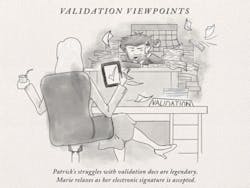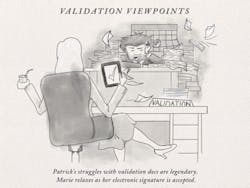In an industry where some of the most forward-looking disease-fighting solutions are being developed why is it still acceptable for these same forward-thinking pharmaceutical and biotechnology companies to be okay with rudimentary, paper-based solutions to document management systems for validation? Why is it the Vault and hundreds of other rooms across the world, housing our validation documentation?
Why Indeed? When industry problems such Production Record Review deviations are the most frequent GMP observations made by the regulatory agencies across the globe? Cited as GMP deficiencies, many of these deviations could be eliminated with the dynamic data technology that exists today. If you ask almost any validation professional what his biggest issues are, these five are almost certainly on the list:
1. Time and resource constraints
2. Inconsistencies / non-standardized practices
3. Visibility of project status in real-time
4. Errors associated with good documentation practices
5. Paper, printing, archiving, storage, retrieval
No question, the creation and management of validation documents is time consuming and costly but often validation teams are so caught up in the huge number of day-to-day details that to step outside for even a day to consider alternative ways to process the documentation is legitimately difficult. Traditional fear about not having a critical piece of information during audit has led to the mountains of legacy paper that exist.
The next generation of validation managers in our industry is a generation that is already looking for and finding document management solutions that save paper, and time, and who believe that by using these new technologies, compliance can be maintained and even improved. This younger generation of engineers and technicians know no other way; like the validation director’s daughter, they have done everything online, always.
AN IDEAL VALIDATION WORLD
Let us start by envisioning the ideal validation world:
• All documents in one place with no ability to check them out or have them disappear, get misplaced or “walk” away
• Global teams can view all comments in real-time
• Teams can conduct collaborative reviews on the same document at the same time
• Have a truly auditable signature trail available in real-time, at the push of a button
• Have a system be paperless, end-to-end, including legacy documentation
• Be audit-ready, so that all documents are available at the push of a button
• Have the ability for a regulatory inspector see exactly, and only, what you want them to see
• Dynamic data that populates all necessary reports, test scripts, protocols after entering information once.
• Tracking on approval cycles easily visible
• Real-time metrics - what is running late, and by whom
• Decrease equipment changeovers (CMOs, pay attention)
• Reporting that is incredibly simple to view, down to the equipment level if necessary, and back up to the highest viewpoint for senior managers
Kneat, as well as several other vendors offer platforms that meet all or a portion of these criteria. The dynamic data functionality is key, however. Entering data once can save dramatically on data entry error and it saves time, by having the documents pre-populated when needed, with the correct data every time.
ASK THE RIGHT QUESTIONS
Asking a few questions when seeking out a validation lifecycle management solution can offer an excellent place to start when identifying a system that best fits your regulatory environment:
1. Has the system been built with CFR Part 11 compliance in mind?
2. Does dynamic data drive the solution?
3. Does the system have an auditable trail of signatures?
4. Is the system completely paperless?
5. Does it offer collaborative review of documents?
6. Can it create, manage and report on all lifecycle documents in a central compliant platform?
7. How easy easily can the new system’s templates be adapted to look like existing templates?
8. How quickly can one create approval templates (workflows) associated with doc types?
9. How many users can securely author different sections of documents at the same?
10. Can this system be run off of mobile devices, on the manufacturing floor?
Validation process can be made more efficient. Many companies are pulling teams together that are asking for lifecycle management validation solutions which would centralize their validation departments for multiple global locations. These folks are looking for those solutions to be online and paperless. Paper mountains and vaults, the legacy of the manual paper-based approach of yesteryear, are no longer accepted as a necessary evil. Validation managers are asking how they can make their process more efficient, and the market is responding. Big data has gone mainstream, and the expectation is that information is available in real-time and in a form that is easily understood and accessed.

